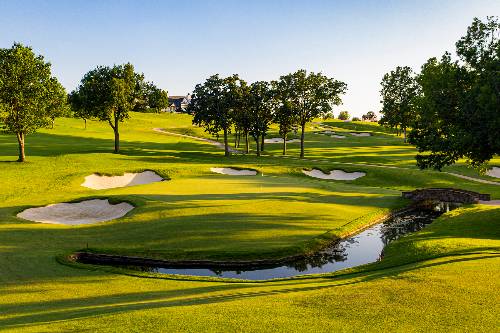
The Southern Hills Country Club that the touring professional golfers will face in the 2022 PGA Championship will bear only a passing resemblance to the 2007 Southern Hills systematically dismantled by Tiger Woods as he won his 13th major and his fourth Wanamaker Trophy. Happily, Southern Hills will appear far more similar to its origins in 1935-36 when Golden Age golf design master Perry Maxwell succeeded in building it in the smothering poverty of Oklahoma’s Dust Bowl as it weathered the worst of the Great Depression.
From such humble beginnings, the club skyrocketed to prominence as an oilman’s escape, and who could argue? High atop the mightiest of all the hills on the property, from the first tee one can see all the way to downtown Tulsa: a stirring sight and as unique and bold a “statement of place” as any opening hole in American golf. If you’re lucky, maybe one of the refineries will be sending a blue dart high into the evening sky, illuminating all the surrounds with its candy cane flame.
Major championships at Southern Hills date back all the way to 1958, but Ben Hogan had been passionately lobbying the USGA to hold the Open there for at least the ten years prior. Tempestuous Tommy Bolt won that Open, staying out if the ferocious Bermuda rough and out of trouble for the week. The normally prickly Bolt had only one outburst during his tournament interactions with the press. Following his Friday round, he proceeded to highlight errata by the Tulsa World columnist in front of the rest of the assembled media after his round. The issue was erroneously printing his age as 49 instead of 36.
“I knew that Tommy,” the hapless scribe offered. “It was a typographical error.”
“The hell it was!” Bolt roared. “It was a perfect four and a perfect nine!”
Since then the winner’s circle has been just as illustrious. Some victors were legends – Woods and Ray Floyd, for instance – others are multiple major winners, (Retief Goosen and Nick Price), while still others won in the crucible of high drama (Dave Stockton holding off Arnold Palmer in 1970 and Hubert Green winning despite being notified of a death threat with four holes to play in the final round).
Gil Hanse – perhaps this era’s most sought-after restoration architect, particularly at major championship venues – made bringing back Maxwell’s design strategies the priority, while also modernizing the course for modern equipment. But there are several critical changes. First, Hanse rolled the edges of greens and brought them closer to the brows edge of the newly reshaped and restored bunkers. Second, Hanse re-routed several small tributaries of the ubiquitous creek that winds through the property so that they cross the fairways in more dangerous places, while also bringing it far more into play on tee shots and approaches. Finally, Hanse took the Weed Whacker to the formidable, clingy, treacherous greenside Bermuda rough, instead introducing his trademark shaved chipping areas and swales to the green surrounds.
The renovations not only modernized Southern Hills, but strengthened it strategically. Once belittled as “too many dog-legs,” (Do they really have dog-legs even in the locker room and the media center dining hall? Yes!) But its real shortcoming was Southern Hills tended to surrender low scores, (most notably 63s that, at the time, equaled the lowest round carded at a major championship). Many pundits agree the club may play both its most authentic and its most difficult, or at least as much as it has in many decades. Let’s take a look at the changes as well as the holes at Southern Hills that may see the widest and wildest swings in scoring.

Hole 1 – par-4, 468 yards.
Hanse made a simple, but critically important strategic change at this hole; he moved the fairway bunkers from the outside of the dogleg to the inside. This hole also introduces the players to the new shaved chipping areas that replace the rings of Bermuda rough so prevalent in past Southern Hills majors.
Hole 2 – par-4, 500 yards.

While 500 yard par-4s have been staples at majors for nearly two decades, the second hole is now defended off the tee by the creek that bisects the fairway in the driving zone. The fairway also winds subtly through the oaks, making positioning off the tee critical to even have a shot to the green.
Hole 4 – par-4, 377 yards.

What was once a simple drive and pitch to a wildly canted green has now gives the players considerably more pause. The fairway slopes hard to the right, towards the newly re-routed creek. That same creek guards the right side of the green with only a shallow strip of shaved grass between the green and a watery grave. The other side of the green runs away 30 yards into a swale or greenside bunker.
Hole 5, par-5, 656 yards.
“There are only two par-5s at Southern Hills, but both are beasts,” confides Golf Digest Senior Architecture Editor Derek Duncan in his tournament preview. Hanse shifted the entire fairway to the right, bringing bunkers that were once in the right rough into the center of the fairway on both the drive and the second shot. Once again the fairway winds dangerously through the oaks, putting a premium on accuracy as well as brute strength.
Hole 7, par-4, 489 yards.
Lengthened by over 100 yards (in 2007 it measured just 384), the green now sits tight to the creek, which also crosses the fairway at the bottom of the drive zone. A breather hole no more, the seventh will see its share of doubles, maybe even some hockey sticks or snowmen. Birdies, on the other hand might prove a stroke-and-a-half gained on the field.
Hole 10, par-4, 441 yards.

Perhaps no hole at Southern Hills needed a spitshine than the tenth. Tucked in a tight corner of the property and doglegging in an awkward place, Tiger Woods played the hole 7-iron off the tee, 7-iron into the green all four days of the 2007 PGA. First, Hanse added 75 yards of length; no more 7-irons off the tee except, perhaps, for Bryson DeChambeau. Better still, Hanse moved the creek so that it bisected the fairway in the landing area. What was once a dictatorial hole with simple targets is now a graduate level examination in planning and execution.
Hole 13 – par-5, 632 yards.
Once again we see the common theme of Hanse’s renovation of routing the stream to cross the fairway in the drive landing zone used to great effect. At the 13th, the closer you get to the ravine off the tee, the more uneven the lies and awkward the stances for the long approach into the green. Playing 95 yards longer than in 2007, it’s unlikely anyone will equal 1994 PGA Championship winner Nick Price’s record on this hole. In ’94 he birdied the 13th all four days.
Hole 15 – par-4, 417 yards.

“It’s the most nightmarish green on the course,” said Hanse in an interview earlier this year. “It’s even worse than 18.” The famous Maxwell rolls as they are called – wild, broad swales that send balls scurrying every which way – are especially treacherous at the 15th.
Still, that’s nothing compared to the nightmare stared down by 1977 U.S. Open winner Hubert Green. Holding the lead with just four holes to play, he was surrounded by police and USGA officials on the the 15th tee. An unidentified woman had called the local police and reported a car with four men was headed to the golf course to shoot Green as he played the 15th hole. Officials gave Green three options: shut the whole shebang down and come back tomorrow, send the crowd home and play the finish with no fans, or play on.
Green paused thoughtfully, then calmly said, “It sounds like some angry ex-girlfriend. I’ll keep playing,” and won his only major championship an hour later. He did have the grace to tell his caddie to steer clear of him just in case though.
Hole 18 – par-4, 491 yards.

A summation of all that came before the drive must avoid the green, while the approach is to a green benched into the clubhouse ridgeline with some of the nastiest internal contours on an already severely tilted location. The 2001 U.S. Open saw a ghastly hockey game break out on the 72nd green as Mark Brooks, Stew Cink, and Retief Goosen all three putted, each fumbling away the trophy and champion’s medal. Goosen eventually outlasted Brooks in an 18 hole playoff, but the clear winner of that Open was Southern Hills.
“Moving the creek and restoring the bunkers makes it a more interesting test off the tee,” said Hanse in an earlier interview. “[But] it’s ultimately going to come down to those small greens….now you have to be more respectful of the edges of the greens, because now those edges just roll away.”
Hanse is right, of course. Moreover, recovery shots are so much more interesting; players now have more creative options. Finally, with several greens now perched precipitously on edges of the creek or bunkers, we’ll see more wild swings on the scoreboard, which means more excitement.





